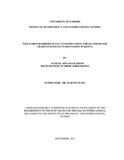| dc.description.abstract | The aim of this study was to identify the non-tariff barriers (NTBs) affecting Kenyan exports in the EAC market, analyze their impact on Kenyan exports and suggest possible policy options for EAC. This was informed by the decline of Kenya‟s exports to EAC by 7.4 per cent from KES 134 billion in 2012 to KES 124 billion in 2013. At the same time there was an increase in exports to Kenya by Tanzania, Rwanda and Uganda during the same period. This was despite the output in Kenya‟s manufacturing industry growing by 4.8 per cent in 2013 compared to 3.2 per cent in 2012. Cross-referencing trade balances between Kenya, Uganda, Rwanda and Tanzania, indicated that the volume of exports to Tanzania had reduced from Sh46 billion to Sh40 billion, while exports to Uganda also reduced from Sh67 billion to Sh65 billion, and to Rwanda from Sh16 billion to Sh13 billion. Ugandan exports to Kenya increasing from Sh15 billion to Sh16 billion, and Rwandan exports going up from Sh822 million to over Sh1 billion. The research findings sought to benefit EAC stakeholders by developing actionable institutional and legal framework to enforce the custom union and the common market protocol. The field of academia may use the findings for further research on the implementation of EAC Customs Union. The research used primary and secondary data collected using interview schedules and questionnaires. The respondents were selected from key informants involved in the negotiation and implementation of the EAC customs union, manufacturers and traders exporting to the EAC market. Data on prices of exports with and without NTBs costs were compiled and analysed. The study analysed the number of reported NTBs from 2007 – 2013 and compared the volume and value of trade of exports to EAC during the period 2007-2013 The data was analysed using qualitative and quantitative approaches. The results of the research indicated that the decline in Kenya‟s export to the EAC in 2012 and 2013 was a result of NTBs imposed by partner states. The rules of origin, the labeling law, anti-dumping and the technical barriers were the most popular of NTBs used against Kenyan products. The research concluded that NTBs have negative impact on Kenya‟s exports to the EAC market. The study observed that the widespread and continued existence of NTBs in the region is as a result of a weak regulatory framework under the custom union and common market protocol. The study recommends that the EAC should establish a competition authority, increase the powers of East African Community Committee on Trade Remedies, and harmonize protection of infant industries and monitoring of effective implementation of the policy on protection of local infant industries in the partner states. | en_US |

